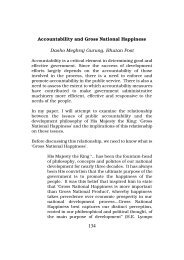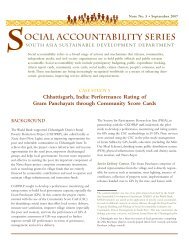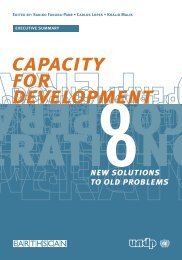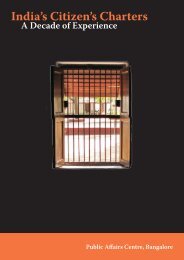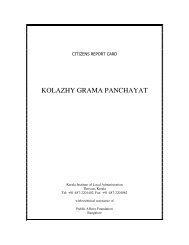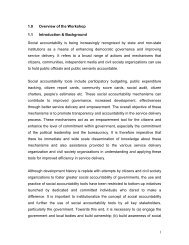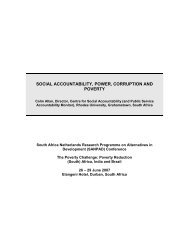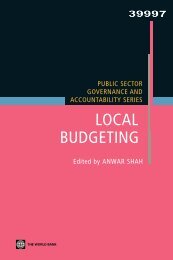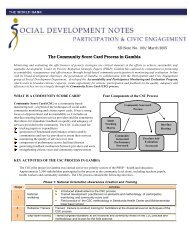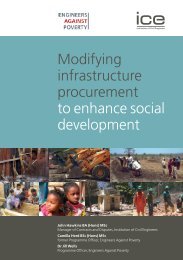Enabling Environment for Social Accountability in ... - SASANet
Enabling Environment for Social Accountability in ... - SASANet
Enabling Environment for Social Accountability in ... - SASANet
You also want an ePaper? Increase the reach of your titles
YUMPU automatically turns print PDFs into web optimized ePapers that Google loves.
The new discipl<strong>in</strong>ary committee <strong>for</strong> judges has found extensive corruption. Dur<strong>in</strong>g the first two years of<br />
the committee’s operation (2003–2004), 31 judges—an astound<strong>in</strong>g 7 percent of all judges—were subject<br />
to discipl<strong>in</strong>ary measures. Given that many judgments were not en<strong>for</strong>ced, there are significant issues<br />
regard<strong>in</strong>g the en<strong>for</strong>cement of legal decisions aga<strong>in</strong>st public authorities such as these justices.<br />
2.1.5 Sociocultural Context<br />
In sociopolitical terms, Mongolian civil society cont<strong>in</strong>ues to be marked by legacies of the old socialist<br />
regime. Under this system voluntary citizen association was highly restricted and state-society relations<br />
were strictly a top-down affair. The high level of political deference and passivity among stakeholders<br />
and the general population underm<strong>in</strong>ed civic engagement and social accountability.<br />
The socialist period was also characterized by large state-controlled mass organizations affiliated with the<br />
rul<strong>in</strong>g MPRP. These “legacy associations”—such as trade unions, the Red Cross, and associations <strong>for</strong><br />
women, youths, and the elderly—cont<strong>in</strong>ue to exist and typically enjoy privileged access to state<br />
resources, re<strong>in</strong><strong>for</strong>c<strong>in</strong>g upward accountability toward public officials rather than downward accountability<br />
to Mongolian civil society.<br />
Religious-based components of civil society among Mongolia’s overwhelm<strong>in</strong>g Buddhist majority have<br />
also been constra<strong>in</strong>ed by the socialist legacy. Buddhist leaders and <strong>in</strong>stitutions were severely repressed <strong>for</strong><br />
decades by the socialist state. Although Buddhism is now experienc<strong>in</strong>g a strong resurgence, along with<br />
other m<strong>in</strong>ority religions, Buddhism has not served as a focal po<strong>in</strong>t of social activism or civic engagement<br />
<strong>in</strong> Mongolia. 27 Rather, a prom<strong>in</strong>ent lama <strong>in</strong> Ulaanbaator (UB) acknowledged that “politicians use the<br />
monks to ga<strong>in</strong> support from the population” by associat<strong>in</strong>g themselves with the monasteries. He noted<br />
that they do not support a political party but rather <strong>in</strong>dividuals who they believe to be honest and<br />
trustworthy and who provide them with access to political resources, quickly add<strong>in</strong>g that after the<br />
elections they never hear from the politicians aga<strong>in</strong>.<br />
In contrast to the historical legacy of socialism, Mongolia’s nomadic culture has re<strong>in</strong><strong>for</strong>ced the need <strong>for</strong><br />
and value of mutual assistance. However, the vast expanse of the Mongolian countryside has constra<strong>in</strong>ed<br />
the development of communal associations, present<strong>in</strong>g a geographic obstacle that expla<strong>in</strong>s the limited<br />
number of community-based organizations <strong>in</strong> Mongolia compared to the multitude of “national” NGOs<br />
based <strong>in</strong> Ulaanbaatar (see annex 3, F<strong>in</strong>d<strong>in</strong>g ORM 8).<br />
2.2 OVERVIEW OF CIVIL SOCIETY IN MONGOLIA<br />
In a relatively short time, Mongolia’s civil society has made notable strides <strong>in</strong> support<strong>in</strong>g economic,<br />
political, and social development, although there rema<strong>in</strong> some significant challenges and obstacles to their<br />
participation <strong>in</strong> civic engagement and social accountability.<br />
2.2.1 Civil Society-State Relations<br />
Although state-society relations have been <strong>in</strong>fluenced by each of the external factors discussed above, the<br />
characteristic political deference and passivity associated with the socialist legacy <strong>in</strong> Mongolia did not prevent the<br />
27 Christian missionary groups have found post-socialist Mongolia to be a fertile ground <strong>for</strong> conversion, which they promote<br />
through INGOs and the English-language-<strong>in</strong>struction programs.




